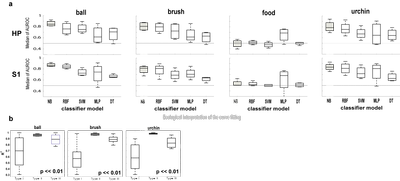Representation of freely-explored objects in the primary somatosensory cortex and hippocampus
Nivaldo A P Vasconcelos (FARN, FAL, IINNELS, UFCG), Edson Anibal Macedo (UFRN), Herman Martins Gomes (UFCG), Gilberto Corso (UFRN), Sidarta Ribeiro (UFRN)
When a rat freely explores an object in the dark and its whiskers touch different parts of the object with different velocities and angles, tactile information reaches the telencephalon with tantalizing spatio-temporal complexity. To investigate the tactile representation of freely-explored objects in the telencephalon, we performed multielectrode extracellular spike recordings from the primary somatosensory cortex (S1) and hippocampus (HP) of adult rats, as they freely explored novel objects in the dark. Neuronal data were fed to five different binary classifiers: multilayer perceptron, radial basis functions, support vector machines, decision tree and naive Bayes classifier. The classifiers were evaluated using the area under a receiver operating characteristic curve (AUROC). In most cases, it was possible to achieve substantial and significant object classification in both S1 and HP (>0.75 AUROC medians, corrected p<0.05). To assess the distribution of information across neuronal ensembles recorded from S1 and HP we performed a neuron dropping analysis, a bootstrap method that reveals how much information is lost, on average, as neuronal ensembles decrease their size from “n” to 1 neuron. We found that significant object classification is achieved with ensembles as small as 10 neurons in both S1 and HP. The best fit for the neuron dropping curves was akin to a type II functional response curve, which in ecology describes the decelerating intake rate of a consumer as a function of food density. We propose that the representation of freely-explored complex objects by neuronal ensembles in S1 and HP is robust, highly distributed, and shaped by the limited availability of non-redundant information to individual neurons.
Support: FINEP, NIDCR, MCT, CNPq, INCT and CAPES.


 Latest news for Neuroinformatics 2011
Latest news for Neuroinformatics 2011 Follow INCF on Twitter
Follow INCF on Twitter
